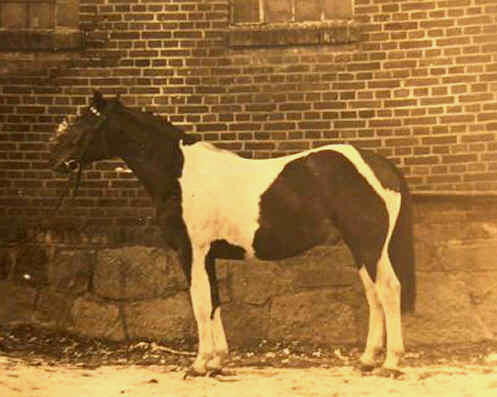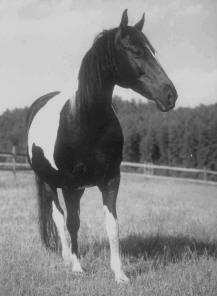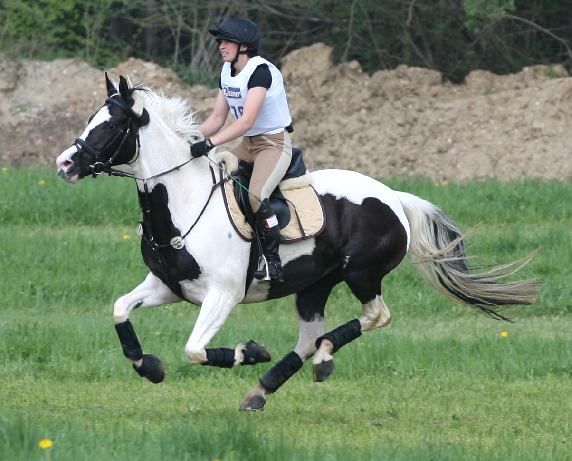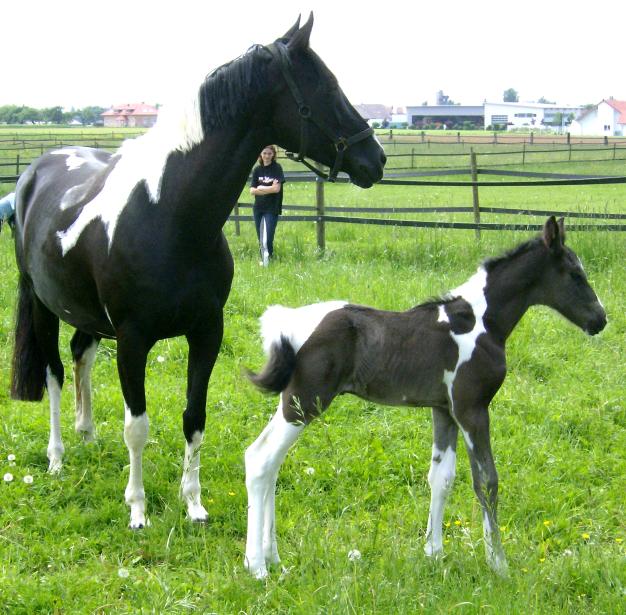| Before the end of
World War II Trakehnen and the traditional
private breeders were looking proudly on countless coloreds all over the
country, a great
number of them Eva offspring.
Her first
pinto foal was a skewbald colt called "Erzschelm" by
the bay Trakehner stallion GRENADIER. He was used as a farm
horse and most probably did not have offspring.
Eva's second
pintofoal was born 1902 and was named EVCHEN (small Eva). She
was piebald and by the TB stallion VOLAPUEK XX, from Graditz.
EVCHEN stayed broodmare in Trakehnen and brought the stallion
ERSTKLASSIG by the TB GREIFF XX. ERSTKLASSIG was used in the
stud of Rastenburg until 1909, from 1910 - 1923 as "test
stallion" in Graditz, in 1924 again as stallion in
Braunsberg und finaly was sold to the private stud of von
Kobylinski in Korbsdorf. He measured 159cm.
Her third
pinto foal, born 1903 was the piebald filly EWIG JUNG (everlasting
young) also by VOLAPUEK XX.
The fourth
pinto foal, born 1904 was the stallion EVA'S SOHN (Evas Son) by
the Trakehner stallion EDELING. Measuring 155 cm, he is
described as a strong and noble stallion with excellent gaites.
Evas Sohn was used in Trakehnen's GUDWALLEN from 1908 until 1920
and was then sold. Besides a lot of important and well known
Trakehner Pintos, the stallion also brought the mare BRANDUNG (see
APART - MANDALA below)
Eva's sixth pinto
foal was a filly, the piebald EFFI (by the TB GREIFF XX. Her son
EFFEKT was one of the most important pinto stallions of that
time and besides his years in Braunsberg and Rastenburg (famous
East Prussian studs) he was also prefered in some of the most
famous private studs of East Prussia. (v. Kobylinsky,
Dohna-Schlobitten, v. Glasow, etc)
Another famous
piebald colt by EVA (# seven) was born 1907 by the
Anglo-Arab stallion SYLVIO. He was given the name of
"EXZELLENZ GOLTZ" (Excellency Goltz). Von Goltz was
another famous Trakehner Pinto breeder. Here in 1937 the
piebald stallion HAUSMEIER, 160 cm,was born who was given to the
stud of Rastenburg in 1940.
Eva's foal # 13
was named EPATA (by the TB Bill of the Play xx). Offspring is
not known.
The last Eva foal
was EDELTRAUT by the Turkestan Tekke DJEIRAN. She became
broodmare in Trakehnen.
After this foal
EVA was killed at the age of 20 years.
|
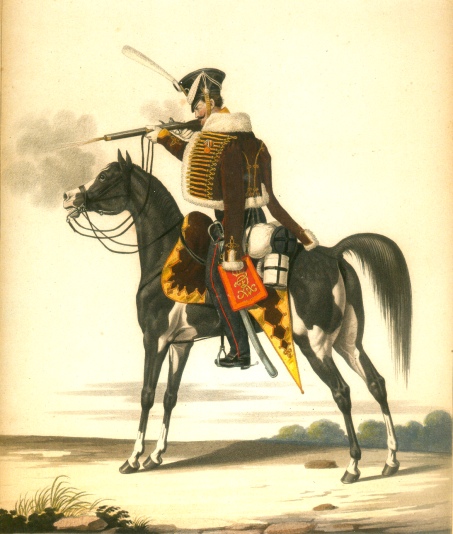
 Married,
two children. Born 1943 in Hamburg, Germany. Lived all
in all 7 years in the Middle East, Bagdad / Iraq - Beirut / Lebanon. From 1964 to 1966
study of Graphic Arts in Hamburg. Domicile since 1970 near Stuttgart, South-Western
Germany. Together with wife Gaby establishment of Colored Trakehner Stud since 1984. In
1987 import of 4 colored mares from Poland, among them the last pure bred EVA descendant
MANDALA and in 1988 import of the legandary piebald stallion REWANZ (Revanche)
who unfortunately died of a pelvis fracture 6 months later. Same year also failure of
recognition of coloreds by Trakehner Association. Since then persisting struggle for
recognition. In 1989 import of the outstanding stallion MAKAR and two further colored
mares. In 1990 foundation of the Interest Group of Friends and Breeders of the Colored
East Prussian Warmblood of Trakehner descent with members all over Germany. In 1995
completition of extensive application for recognition of pure bred colored Trakehners,
also basing on historical facts. In 1996 finally a breakthrough. All suggestions of the IG
were accepted and in the same year 3 colored mares of members of the IG
registered.
( By end of 1999
12 mares, in 2009 more than 100)
Married,
two children. Born 1943 in Hamburg, Germany. Lived all
in all 7 years in the Middle East, Bagdad / Iraq - Beirut / Lebanon. From 1964 to 1966
study of Graphic Arts in Hamburg. Domicile since 1970 near Stuttgart, South-Western
Germany. Together with wife Gaby establishment of Colored Trakehner Stud since 1984. In
1987 import of 4 colored mares from Poland, among them the last pure bred EVA descendant
MANDALA and in 1988 import of the legandary piebald stallion REWANZ (Revanche)
who unfortunately died of a pelvis fracture 6 months later. Same year also failure of
recognition of coloreds by Trakehner Association. Since then persisting struggle for
recognition. In 1989 import of the outstanding stallion MAKAR and two further colored
mares. In 1990 foundation of the Interest Group of Friends and Breeders of the Colored
East Prussian Warmblood of Trakehner descent with members all over Germany. In 1995
completition of extensive application for recognition of pure bred colored Trakehners,
also basing on historical facts. In 1996 finally a breakthrough. All suggestions of the IG
were accepted and in the same year 3 colored mares of members of the IG
registered.
( By end of 1999
12 mares, in 2009 more than 100) 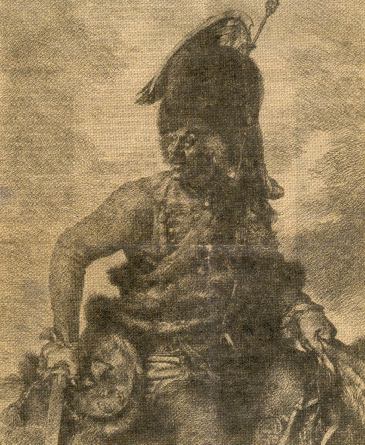

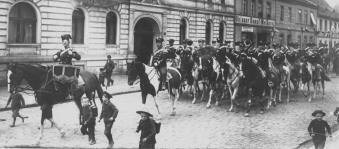
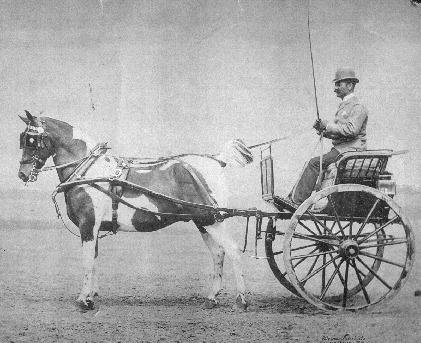
 Famous
Ohlau Trumpeter Husars in former Silesia. The only Prussian
cavalry regiment mounted on colored horses from East Prussia and
Trakehnen.
Famous
Ohlau Trumpeter Husars in former Silesia. The only Prussian
cavalry regiment mounted on colored horses from East Prussia and
Trakehnen.
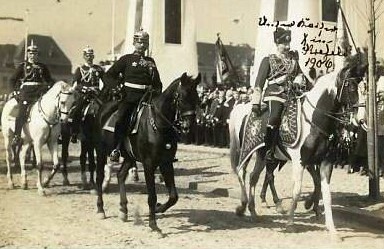
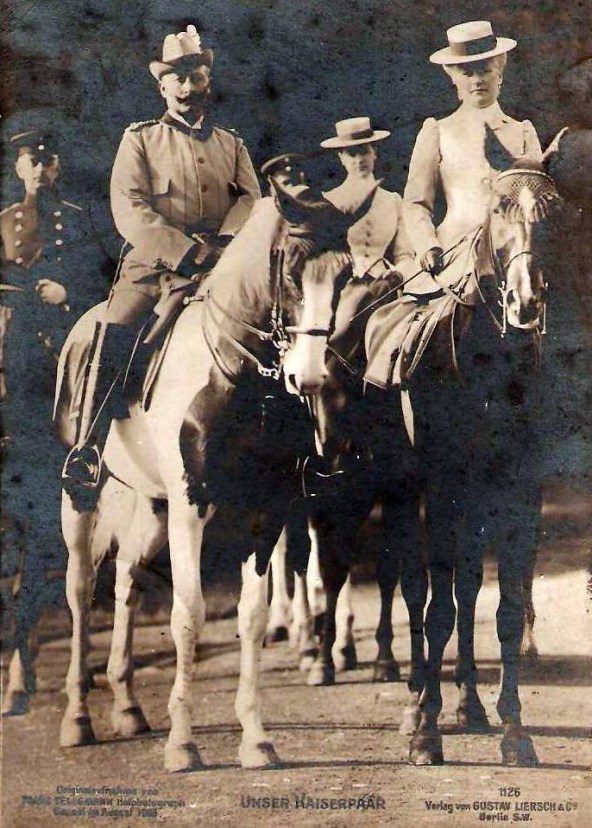
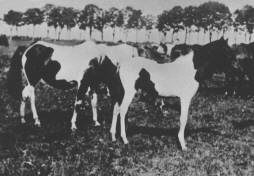
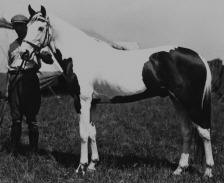

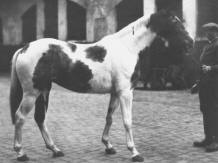

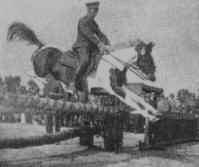

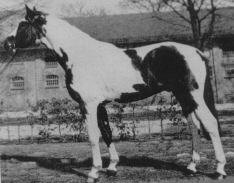
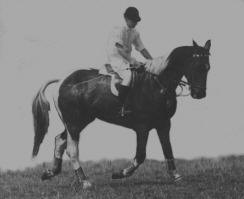
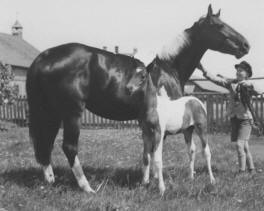
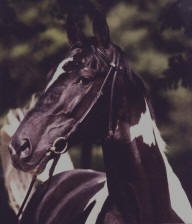 Photo Bernd Eylers
Photo Bernd Eylers
